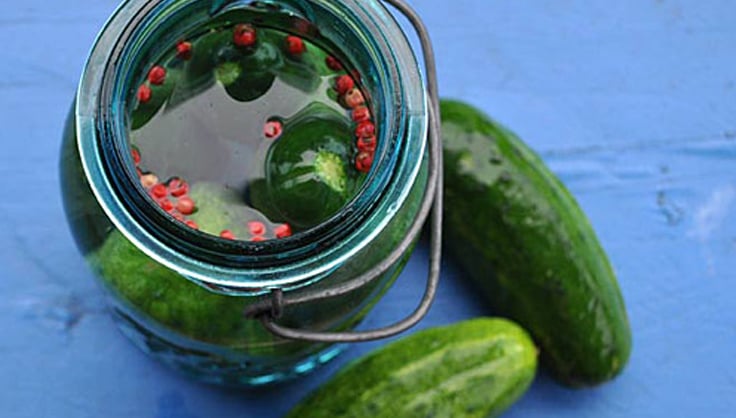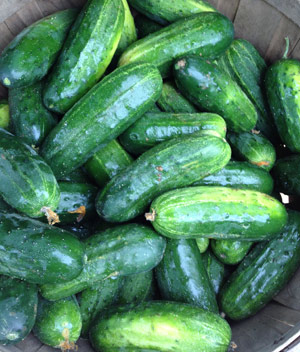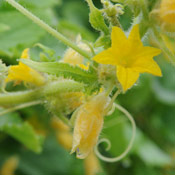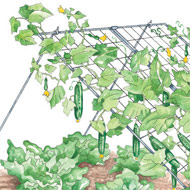Making Perfect Pickles, from Cuke to Crunch

I'm passionate about pickles. That's why caring for my cucumber crop tops my list of garden chores. Sure, beets, green beans, cabbage, squash, fiddleheads and onions (for cocktails!) all make great pickles, but a crispy, tangy cucumber pickle is the thing that makes every burger complete and turns a sandwich into a lunch. There is nothing worse than a soggy, limp, crunch-less pickle. When I make pickles, my biggest goal is to make sure they stay crisp!
Pickling most vegetables is really pretty easy. Fresh veggies, sterile jars, a good kettle and some basic ingredients are all you need. The most important equipment is your taste buds. Pickling is about balancing salt, acidity from the vinegar, spices, and the natural sweetness of the vegetables. Recipes are a great place to start, but don't be afraid to try new combinations and variations to suit your tastes. From traditional half-sours and garlicky spears to bread-and-butter slices and traditional dill chips, there are endless combinations of spices, but just a few key techniques to ensure crispness.
Great pickles start with great cucumbers. Specific pickling varieties aren't necessary, but their size and thin skin make them ideal. Kirby is probably the most popular, but others, such as Calypso and National Pickling, also work well in a home garden. Although there are yellow- and white-skinned varieties, I'm partial to the traditional dark green ones. The single most important factor, though, is thin skin. A thick, waxy skin slows or prevents the brining process, yielding a very soggy pickle with a "one note" flavor. When you're harvesting your cucumbers (even if it's from the bin at the grocery store or farmer's market) look for small, firm, thin-skinned cukes and save the glossy waxed ones for salad. If you're growing cukes in the garden, harvest them while they're still on the small side — 4" to 6" long.
I try to harvest enough for one batch all at one time. For me, that's 10 to 12 cukes, or enough to fill four pint jars. Harvesting just before you start the pickling process helps ensure that the sugar content is still high and consistent among all the fruit, and that the skin is firm and undamaged. I also try to harvest them before they fatten up too much. Fresh, thin, firm cukes have the most sugar in them, which — if you're making a brined or fermented pickle — allows for the most good bacteria to go to work and results in more flavor. If you're making a preserved pickle, freshly harvested cucumbers are still best because they will hold on to more of their natural sweetness to balance the acidity of the vinegar. Once you've got your cucumbers, the next step depends on which kind of pickle you're making.
Fermented Cucumbers
For a traditional half-sour or dill pickle — the kind you'd get at a good deli — you'll be fermenting. Making a fermented pickle is quick and easy, and you should set about it soon after harvesting. All you need are clean jars, coarse salt, ice-cold water and dill, garlic or whatever other flavors you want to add. Use pickling salt or kosher salt that is free of iodine and anti-caking agents because these additives can discolor your pickles.
Start by sterilizing your pint jars. Wash the cucumbers, taking care to remove any remnants of the flower. Pack the jars tightly with cucumbers. I can usually fit three cucumbers per jar. Add herbs, spices and other flavorings to the jar.
Next, in a bowl or large measuring cup, combine the salt and cold water. Start with about 1 tablespoon of salt per cup of water; you can vary the amount to taste. Stir until the salt is dissolved, and then pour this salt solution (brine) into the jars, making sure the cucumbers are fully submerged.
Let the jars sit at room temperature for two or three days. Some folks seal the brining jars while they sit on the counter, but I prefer to create an air-permeable temporary lid using a double layer of cheesecloth and rubber band. While it might seem a little weird to leave an unsealed jar of cucumbers on the counter for three days, doing so allows beneficial microbes in the air to work their magic, adding flavor during the fermentation process. The longer the pickles ferment, the more sour they get. For the best taste and crunch, refrigerate after 3 or 4 days. If any foam forms on the top of the brine, simply skim it off. These pickles will keep for about a week.

For best results, make pickles the same day you harvest them.
Preserved Pickles
If you're in for the long haul, you're making a preserved pickle — one made with vinegar and canned in a hot-water bath. Here is where recipes really vary. I'm not going to recommend any one direction, just two must-dos for a crispy outcome.
As soon as possible after harvesting, wash and slice the cucumbers and put them in a colander. Toss them with a few good pinches of coarse salt and mix in a tray of ice cubes. Set the colander in a bowl, cover with plastic wrap and let it stand in the fridge until you are ready to process the pickles. You'll want to rinse and drain them before packing them in the jars, but this step — keeping the cucumbers salted and cold — will give you a great snap.
The second must-do goes hand in hand with the first: Don't cook the cucumbers. No matter what the recipe says, make the vinegar and spice mixture as directed (some require a boil and some not), but don't cook the cukes. Simply pack the cucumbers in the jar and pour the hot mixture over them.
Finally, process the jars in a hot water bath until they are sealed. Canned pickles need about a week to come to full flavor, but two weeks is better.
Grow Your Own
Learn to grow cucumbers in the Vegetable Encyclopedia.


The Cucumber Trellis keeps the fruit off the ground as it ripens.
Tips
- Cukes are hot weather plants. They hate cold soil and cold weather. The soil should be at least 65 degrees, preferably 70 degrees, when planting.
- The striped cucumber beetle is a serious problem in many areas. Learn to identify and control this pest.
- There are two basic types of cukes: bush and vine. Vining cukes typically produce more fruit than the bush varieties.
- The more cucumbers you pick, the more you get. Never let cukes get big and seedy or the plant will assume that its work is done.
- Although there are varieties listed as pickling cukes and others called slicers, either kind can be pickled or eaten fresh in salads.
Last updated: 01/04/2023
Print this Article:
Get the Dirt
Stay up to date on new articles and advice. Please fill out the information below.
